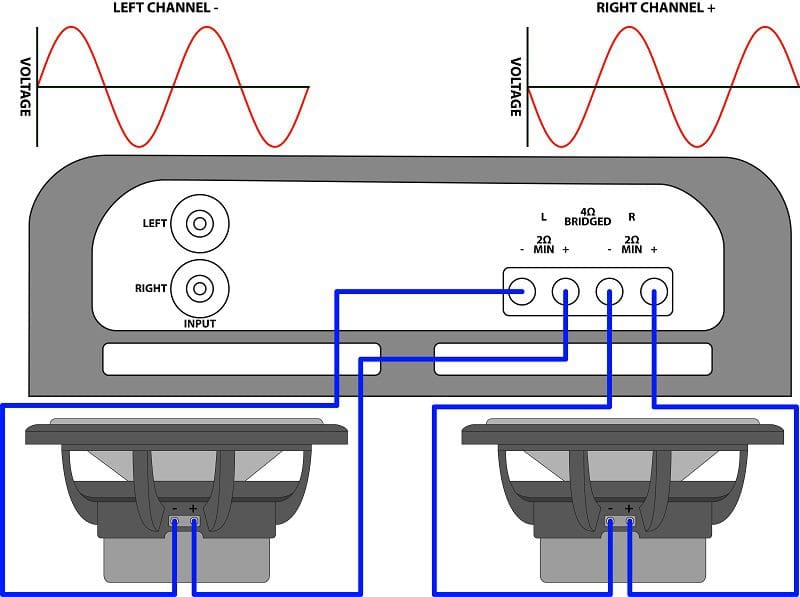

If your speaker’s ohms are too low for your amplifier you run the risk of blowing out your speakers and frying your amplifier completely. But it is very important to know exactly what your amplifier can handle. Now, amplifiers are generally designed to work with 4, 8, and 16-ohms speakers. The second rule of thumb of this matching amplifier to speakers guide: Match your speaker’s ohms to the ohms that your amplifier can handle. So that brings me to the second rule of thumb. Now we are getting back into Ohms, a concept explained above. Since my pair of JBL jrx 125 each had a power capacity of 500 watts in a 4-ohm load I was looking for an amplifier that could push at least 750 watts per channel in a 4-ohm load. Thus, whatever you do do, do not under power your speakers unless you want to ruin your amplifier. You would be pushing it to its limits and it would wear out pretty quickly. But if instead it is rated at 500 watts pushing a 500-watt speaker would be more like the equivalent of a strenuous run. Therefore, if my amplifier is rated at 800 watts pushing a 500 watts speaker, it will be equivalent to an easy paced walk. If you are on foot, you can walk a lot further than you can run before you are completely exhausted and have to stop. The job of the amplifier is to pump watts to your speakers. This is because your amplifier is also doing work for you. Now your amplifier needs to be 50 percent more powerful than your speakers. It is way too much work for them to do but 500 watts is fine. if I tried to play 2,000 watts out of my JBL’s (declared by the manufacturer as the “Peak Power Capacity”) I would probably blow them to smithereens. You should be ignoring, for now, the attribute “Peak power capacity”. Other specification sheets may call it “Continuous Power Capacity” RMS Power handling or Program Watts, but they all mean the same thing. There are two numbers: one was the Power capacity which was 500 watts. Remember our specification sheet example. Your speaker can only do so much work over a long period of time. Thus, the more watts they get, the more work they have to do. The first rule of thumb: get an amplifier that is 50% more powerful than your speakers when your amplifier sends watts to your speakers, it is making them work. Now there are two main rules of thumb when choosing an amplifier for this matching amplifier to speakers guide. You should never turn on the amplifier without a speaker connected. With that information, I was ready to choose an amplifier. With all the specs pulled up, I was only interested in a couple of numbers of this specifications sheet: the “Nominal impedance” (for example 4 Ohms), and the “Power capacity” (for example 500 Watts).

Thus, the first thing to do was to find the specifications of the speakers. Therefore, I had to find an amplifier before I could get any sound out of them. They each have a horn and two 15-inch speakers and I think they sound really good. I explain to you here what to look in the specifications of the amplifier and in the specification of the speaker. The main part of this matching amplifier to speakers guide is this part. Step By Step Matching Amplifier and Speaker If you just want to match an amplifier with a set of speakers, just keep reading our step by step approach. Impedance is thoroughly described in a separate paragraph inside this matching amplifier to speakers guide, but well below in the article. If instead, it has fewer ohms, that means electricity runs through it really easily.Ī thick piece of rubber, for example, has a lot more ohms than a metal pole.Īlso for our purposes today, resistance and impedance mean the same thing: They are both measured in ohms. If something has a lot of ohms it means that electricity has trouble getting through. Now, ohms are all about resistance to electricity. Ohms And Wattsīefore we begin with this matching amplifier to speakers guide, you need to know about ohms and Watts. Once this is understood, the rest of the matching amplifier to speakers guide becomes very simple. We have to start explaining what are Ohms and Watts. We start defining Ohms and Watts according to current standards too.īasically, amplifiers (often also called amps) amplify an audio signal so that the desired level is emitted from the loudspeakers. Just go below to the step by step guide to understand everything in five minutes. This is the procedure for matching amplifier to speakers guide according to current standards.


 0 kommentar(er)
0 kommentar(er)
